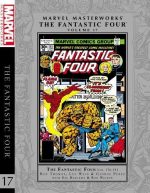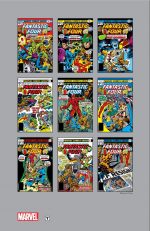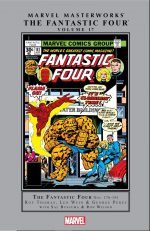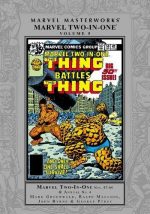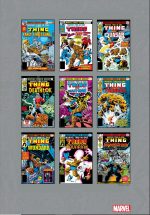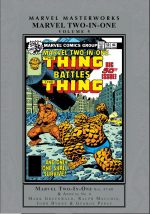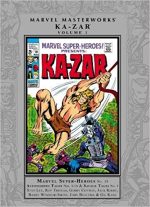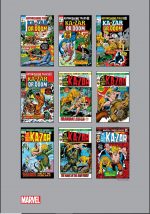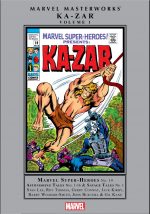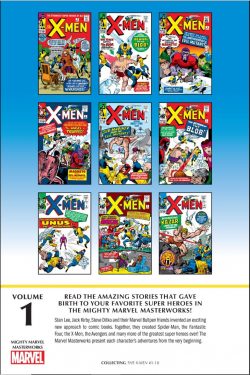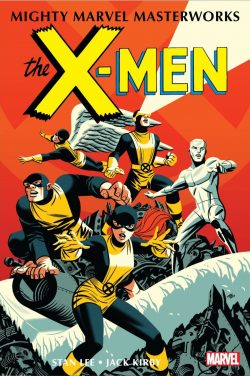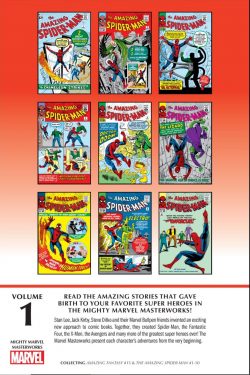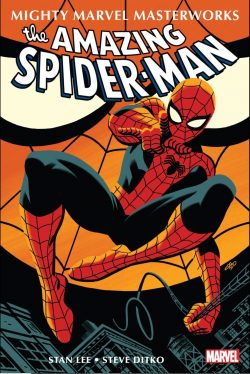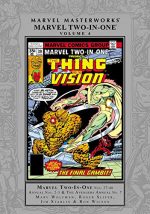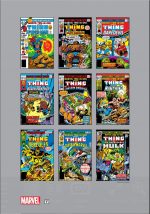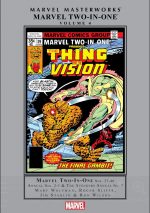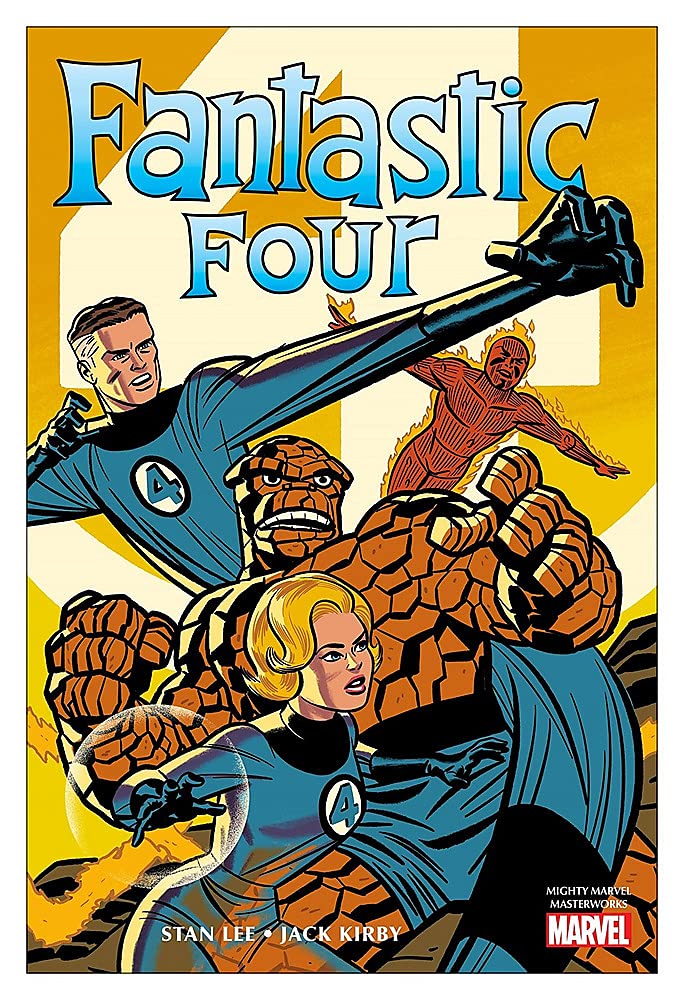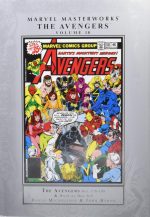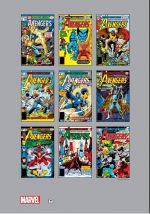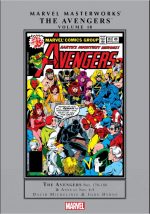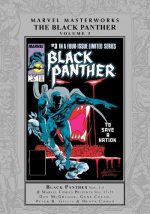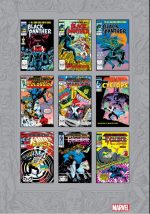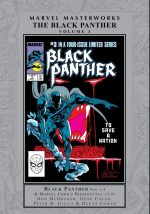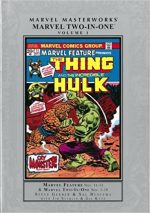
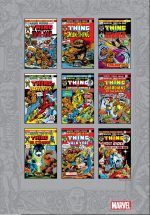
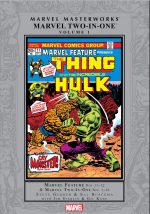
By Steve Gerber, Len Wein, Mike Friedrich, Chris Claremont, Jim Starlin, Gil Kane, Sal Buscema, George Tuska, Herb Trimpe, Bob Brown & various (Marvel)
ISBN: 978-0-7851-6633-7 (HB)
Imagination isn’t everything. As Marvel slowly grew to a position of dominance in the wake of losing their two most innovative and inspirational creators, they did so less by risky experimentation and more by expanding and exploiting proven concepts and properties.
The only real exception to this was their en masse creation of horror titles in response to the industry down-turn in super-hero sales – a move expedited by a rapid revision in the wordings of the increasingly ineffectual Comics Code Authority rules.
The concept of team-up books – an established star pairing, or battling – and usually both – with less well-selling company characters, was not new when Marvel decided to award their most popular hero the lion’s share of this new title, but they wisely left their options open by allocating an occasional substitute lead in the Human Torch. In those long-lost days, editors were acutely conscious of potential over-exposure – and since super-heroes were actually in a decline, they may well have been right.
After the runaway success of Spider-Man‘s collaborations in Marvel Team-Up, the House of Ideas reinforced the trend with a series starring bashful, blue-eyed Ben Grimm – the Fantastic Four‘s most iconic member – beginning with two test runs in Marvel Feature before graduating to its own somewhat over-elaborate title.
This compelling compendium – available in hardback and digital formats – gathers the contents of Marvel Feature #11-12 and Marvel Two-In-One #1-10, covering September 1973 – July 1975, and opens with a Roy Thomas Introduction explaining how it was Stan’s idea…
Then the much told tales take centre stage with a perennial favourite pairing and the Thing once more clashing with The Incredible Hulk in ‘Cry: Monster! by Len Wein, Jim Starlin & Joe Sinnott (from MF #11).
Here, Kurrgo, Master of Planet X and the lethal Leader manipulate both blockbusting brutes into duking it out – ostensibly to settle a wager – but with the mighty minded, misshapen masterminds each concealing hidden agendas…
That ever-inconclusive yet cataclysmic clash leaves Ben stranded in the Nevada desert where Mike Friedrich, Starlin & Sinnott promptly drop him in the middle of the ongoing war against mad Titan Thanos with Iron Man helping Ben crush monstrous alien invaders in ‘The Bite of the Blood Brothers!’ (Marvel Feature #12, November 1973): another spectacular and painfully pretty all-action punch-up.
Still stuck in the desert when the dust settles, Ben laboriously treks to a minor outpost of civilisation just in time to be diverted to Florida for the grand opening of his own title. Cover-dated January 1974, Marvel Two-In-One #1 sees Steve Gerber, Gil Kane & Sinnott magnificently detail the ‘Vengeance of the Molecule Man!’, with Ben learning some horrifying home truths about what constitutes being a monster after battling with and beside ghastly, grotesque anti-hero Man-Thing.
With the second issue Gerber cannily trades a superfluous supporting character from his Man-Thing series to add some much-needed depth to the team-up title. ‘Manhunters from the Stars!’ pits Ben, old enemy Namor, the Sub-Mariner (another series Gerber was currently writing) and the Aquatic Avenger’s feisty and single-minded cousin Namoritaagainst each other as well as aliens hunting the emotionally and intellectually retarded superboy Wundarr. Another dynamically, intoxicating tale illustrated by Kane & Sinnott, this case also leaves the Thing as de facto guardian of the titanic teenaged tot…
Sal Buscema signed on as penciller with #3 as the Rocky Ranger joins the Man Without Fear ‘Inside Black Spectre!’: a crossover instalment of the extended epic then playing out in Daredevil #108-112 (in case you’re wondering, this action-packed fight-fest occurs between the second and third chapters) after which ‘Doomsday 3014!’ (Gerber, Buscema & Frank Giacoia) finds Ben and Captain America visiting the 31st century to save Earth from enslavement by the reptilian Brotherhood of Badoon, leaving Wundarr with Namorita for the foreseeable future…
The furious future-shocker concludes in MTIO #5 as the original Guardians of the Galaxy (not the movie group) climb aboard the Freedom Rocket to help our time-lost heroes liberate New York before returning home. The overthrow of the aliens was completed by another set of ancient heroes in Defenders #26-29 (which is also the subject of a different review)…
Marvel Two-In-One #6 began a complex crossover tale with the aforementioned Defenders as Dr. Strange and the Thing witness a cosmic event which begins with a subway busker’s harmonica and leads inexorably to a ‘Death-Song of Destiny!’ (Gerber, George Tuska & Mike Esposito) before Asgardian outcasts Enchantress and the Executioner attempt to seize control of unfolding events in #7’s ‘Name That Doom!’ (pencilled by Sal Buscema).
As they are thwarted by Grimm and the valiant Valkyrie, there’s enough of an ending here for casual readers, but fans and completists will want to hunt down Defenders #20 or Defenders Masterworks link please volume 3 for the full story…
Back here, however, MTIO #8 teams Grimm and supernatural sensation Ghost Rider in a quirkily compelling Yuletide yarn. ‘Silent Night… Deadly Night!’ – by Gerber, Buscema & Esposito – finds the audacious Miracle Man trying to take control of a very special birth in a stable…
Gerber moved on after plotting Thor team-up ‘When a God goes Mad!’ for Chris Claremont to script and Herb Trimpe & Joe Giella to finish: a rushed and meagre effort with the Puppet Master and Radion the Atomic Man making a foredoomed power play, before issue #10 concludes this initial compendium.
Crafted by Claremont, the still much-missed Bob Brown & Klaus Janson, it is a slice of inspired espionage action-intrigue with Ben and the Black Widow battling suicidal terrorist Agamemnon who plans to detonate the planet’s biggest nuke in blistering thriller ‘Is This the Way the World Ends?’.
These stories from Marvel’s Middle Period are of variable quality but nonetheless represent an honest attempt to entertain and exhibit a dedicated drive to please. Whilst artistically the work varies from adequate to utterly superb, most fans of the frantic Fights ‘n’ Tights genre would find little to complain about.
Although not really a book for casual or more maturely-oriented readers there’s still buckets of fun on hand and young readers will have a blast, so why not to add this colossal comics chronicle to your straining superhero bookshelves?
© 2020 MARVEL

